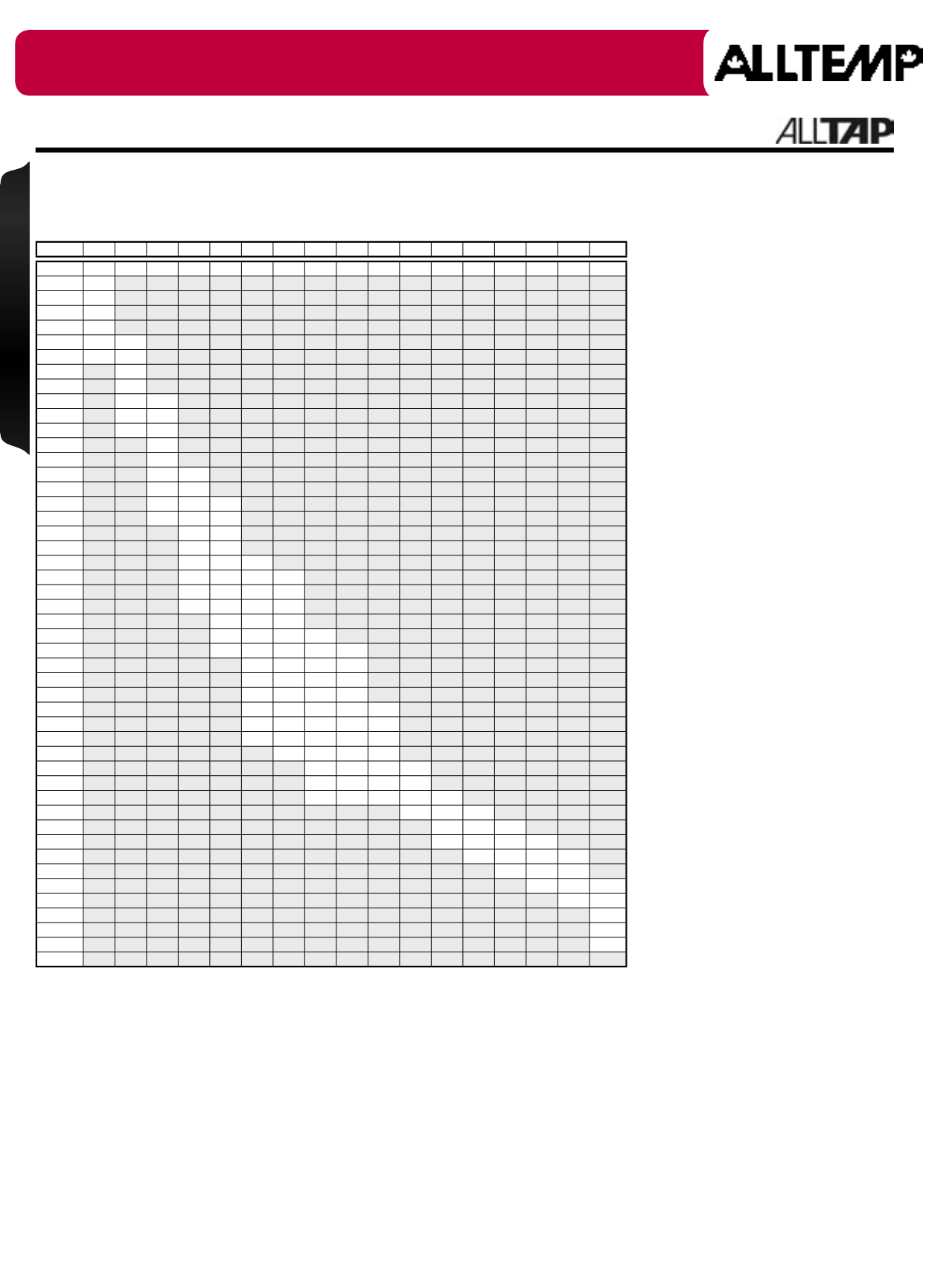
73
Refrigeration
Capillary Tubing
Part# TC-26 TC-31 TC-36 TC-42 TC-44 TC-49 TC-50 TC-54 TC-55 TC-59 TC-64 TC-70 TC-75 TC-80 TC-85 TC-90 TC-100
Tube ID .026 .031 .036 .042 .044 .049 .050 .054 .055 .059 .064 .070 .075 .080 .085 .090 .100
.024
1.44
.025
1.20
.026
1.00 2.24
.028
.72 1.59
.030
.52 1.16
.031
.45 1.00 2.00
.032
.86 1.75
.033
.75 1.54
.034
.65 1.35
.035
.58 1.16 2.31
.036
.50 1.00 2.10
.037
.45 .90 1.79 2.22
.038
.39 .80 1.59 1.92
.039
.35 .71 1.41 1.75
.040
.31 .62 1.25 1.55 2.51
.041
.28 .56 1.12 1.38 2.26 2.50
.042
.25 .50 1.00 1.24 2.03 2.23
.043
.23 .45 .87 1.11 1.83 1.98
.044
.20 .39 .81 1.00 1.62 1.79
.045
.35 .73 .90 1.47 1.60 2.32
.046
.32 .67 .82 1.34 1.47 2.08 2.27
.047
.59 .74 1.20 1.31 1.89 2.06
.048
.54 .67 1.10 1.20 1.72 1.87
.049
.49 .61 1.00 1.09 1.55 1.69
.050
.45 .56 .91 1.00 1.43 1.56 2.14
.051
.41 .51 .84 .93 1.31 1.44 1.96
.052
.47 .76 .85 1.19 1.32 1.78
.053
.43 .69 .78 1.09 1.20 1.64
.054
.39 .65 .70 1.00 1.09 1.52 2.18
.055
.36 .59 .64 .92 1.00 1.38 2.00
.056
.54 .60 .85 .94 1.27 1.85
.057
.50 .55 .79 .87 1.17 1.72
.058
.46 .51 .73 .80 1.07 1.56
.059
.42 .47 .67 .73 1.00 1.44 2.18
.060
.39 .43 .62 .67 .93 1.33 2.04
.064
.32 .47 .50 .69 1.00 1.50 2.07
.070
.30 .33 .46 .67 1.00 1.37 1.84
.075
.48 .73 1.00 1.37 1.75
.080
.54 .74 1.00 1.32 1.71
.085
.57 .76 1.00 1.29
.090
.43 .62 .76 1.00 1.62
.095
.46 .60 .79 1.27
.100
.48 .62 1.00
.105
.49 .80
.110
.65
.115
.53
.120
.43
Capillary Tubing - Length Conversion Chart
This conversion chart enables the user to translate the recommended length of tube diameter into sizes stocked by
J/B. In using the chart it is recommended that conversions be made using factors within the unshaded area.
To Use Chart
1. Locate recommended cap
tube I.D. in left hand column.
2. Read across and find
conversion factor under copper
cap tube size.
3. Multiply the given length of the
recommended cap tube by the
conversion factor.
4. The resultant length (Min.
5'/ Max.16') of copper cap
tube will give the same flow
characteristics as the original
recommended cap tube.
Example
Recommended cap tube: 9'–.040 I.D.
Locate .040 in left hand column and
reading across gives the following
conversion factor: No. TC-36 (.62) and
TC-42 (1.25).
Multiplying the recommended cap
tube length of 9' by the conversion
factor gives the following results:
51⁄2"-TC-36 and 111⁄4'–TC-42. Either
of these two cap tubes will give the
same results as the original cap tube
of 9'–.040 I.D.
Conversion Chart - Purpose
The "Capillary Tube Length Conversion Chart" was developed to enable users of capillary tubing to use the
standard tubing sizes which are available through Refrigeration Jobbers everywhere.
While many original equipment manufacturers and condensing unit manufacturers recommend specific lengths and
diameters of capillary tubing for their units, these tube sizes are not always readily available except of special order.
This conversion chart enables the user to translate the recommended length into that of a tube diameter that can
be quickly obtained. In using the chart, it is recommended that conversions be made using factors within the
unshaded area. In addition, it is highly recommended that the minimum length of capillary used be 5 feet.
Capillary Tubing


